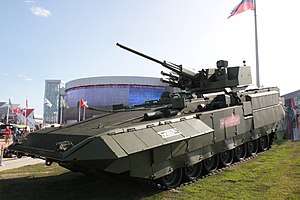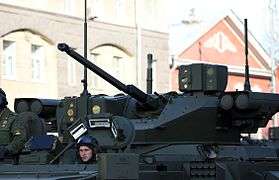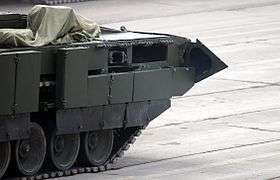T-15 Armata
The T-15 Armata (Russian: T-15 Армата), with industrial designation "Object 149", is a Russian heavy infantry fighting vehicle first seen in public (initially with its turret covered) in 2015 during rehearsals for the Moscow Victory Day Parade. The T-15 is expected to replace the BMP-2 and MT-LB based platforms of the Russian Ground Forces.[8][5]
| T-15 Armata | |
|---|---|
.jpg) Russian Army T-15 Armata during the 2015 Moscow Victory Day Parade | |
| Type | Heavy IFV (HIFV) |
| Place of origin | Russian Federation |
| Service history | |
| Used by | Russian Ground Forces |
| Specifications | |
| Mass | 48 tons[1] |
| Armor | Steel and ceramic composite 1,200–1,400 mm vs HEAT[2] |
Main armament | Bumerang-BM remote weapon station turret with 30 mm automatic cannon 2A42, 9M133 Kornet-EM anti-tank missiles, and PKT 7.62 mm coaxial machine gun[3][4] with 500 rounds (AP/HE)[5] or DUBM-57 Kinzhal remote weapon station turret with 57mm BM-57 autocannon and Ataka-T ATGM missiles[6] or AU-220M Baikal remote weapon station with BM-57, coaxial PKMT machine gun, and 9M120-1 Ataka ATGM missiles[7] |
| Engine | Multifuel diesel engine 1,500 hp |
| Payload capacity | 9 infantry (+3 crew) |
| Transmission | automatic |
Operational range | 550 km (340 mi) |
| Maximum speed | 65–70 km/h (40–43 mph) (road) |
Background
The infantry fighting vehicle concept was first conceived of in the 1960s during the Cold War, where a confrontation between NATO and Warsaw Pact countries was expected to be dominated by tanks, so infantry required transport to sustain the pace of advance while having armament to fight tanks and armor to withstand machine gun and artillery fire; the Soviet Union created the BMP-1/BMP-2 and the United States the M2 Bradley. While IFVs provided troops with heavier mounted firepower, the amount of anti-tank rockets and guided missiles made it impractical and uneconomical to protect them from such weapons. Post-Cold War, rather than maneuver warfare, most fighting took place in urban areas, such as the battles for Grozny by Russia. While heavy losses could be tolerated in a superpower war, insurgent ambushes with anti-tank weapons easily killing whole squads at once by destroying their IFV have become unacceptable. In an effort to field better protected troop carriers, some countries have experimented with converting tank hulls to carry dismounts, such as Israel with Namer.[2]
The Russian T-15 is based on the T-14 tank hull, with its engine relocated to the front to accommodate a passenger compartment in the rear, which adds the engine as a type of shield against frontal hits; passenger capacity is estimated at between seven and nine troops. At 48 tons, the vehicle is slightly heavier than the T-90 main battle tank. It has several features, including a built-in entrenching blade and the T-14's numerous cameras and sensors.[2]
Design
Armament

The T-15 Armata is armed with either the Bumerang-BM (Epoch) remote control weapon station turret with a 2A42 30 mm autocannon, a 7.62 mm coaxial PKT and a bank of two 9M133M Kornet-M anti-tank guided missiles on both sides[3] or the AU-220M Baikal remote turret that features a 57 mm autocannon BM-57 and the 9M120-1 Ataka guided anti-tank missiles.[1][9] or DUBM-57 Kinzhal RCWS with BM-57 autocannon, 7.62mm PKMT machine gun, and 9M120-1 Ataka ATGMs.[10]
Mobility
Like the T-14, the T-15 is based on the Armata Universal Combat Platform, but unlike the T-14 it has its engine in the front.[5] It is powered by a new generation 1,500 hp multifuel diesel engine coupled with a hydro-mechanical automatic transmission, has a combat weight of about 48 tons, a maximum road speed of 65–70 km/h (40–43 mph), an operational range of 550 km (340 mi), and a power-to-weight ratio of over 30 h.p./t.[1]
Protection
Like the T-14, the T-15 is protected by reactive armour[4] and the Afganit (Russian: Афганит) active protection system. While the T-14 has its Afganit launch tubes at the base of its turret, the T-15 has them arrayed along the top sides of its hull.[5] It uses four soft-kill launchers to deploy smoke grenades that disrupt visual and infrared guidance systems, and five hard-kill launch tubes on top of the hull, compared to the T-14's ten hard-kill tubes on the turret which automatically turns to face a threat.[2] The T-15 has "an unprecedented level of armor protection," including improved passive steel and ceramic composite plate armor and a slat armor cage at the rear. Its new Malakhit (Malachite) ERA is claimed to protect against ATGMs like the FGM-148 Javelin and Missile Moyenne Portée (MMP) and 120 mm tank rounds like the German DM53/DM63 and American M829A3 APFSDS sabots. In addition to hard-kill and soft-kill APS, the developer uses a special paint that significantly reduces the vehicle's infrared signature. The floor is reinforced with an additional armor plate for counter-mine and counter-IED protection, and it has a jamming system to detonate radio-controlled anti-tank mines. The T-15 has an NBC protection system.[1]
Operators
See also
- Armata Universal Combat Platform
- T-14 Armata
- Kurganets-25
- VPK-7829 Bumerang
- Bumerang-BM - Epoch remote control turret
- Typhoon (AFV family)
- Namer - Israeli HAPC on the Merkava chassis
Image gallery
 Close-up of turret
Close-up of turret.jpg) Front view
Front view- Side view
.jpg) Rear view with the rear ramp door
Rear view with the rear ramp door Close-up of engine exhaust ports in the front
Close-up of engine exhaust ports in the front
References
- T-15 Armata HIFV to increase combat capabilities of Russian Land Forces Archived 13 August 2016 at the Wayback Machine – Armyrecognition.com, 10 August 2016
- Russia's T-15 Armata: Moscow's Fighting Vehicle of the Future? Archived 23 September 2016 at the Wayback Machine – Nationalinterest.org, 18 September 2016
- de Larrinaga, Nicholas (22 April 2015). "New Russian heavy armour breaks cover". IHS Jane's Defence Weekly. Archived from the original on 21 April 2016. Retrieved 16 May 2015.
- "T-15 (Object 149) heavy infantry combat vehicle". globalsecurity.org. Archived from the original on 18 May 2015. Retrieved 16 May 2015.
- "New Russian Armor; First analysis: Armata". defense-update.com. 9 May 2015. Archived from the original on 18 May 2015. Retrieved 16 May 2015.
- "Russian Bumerang IFV may be equipped with the Kinzhal module | October 2018 Global Defense Security army news industry | Defense Security global news industry army 2018 | Archive News year". Archived from the original on 12 October 2018.
- "Cloud from shrapnel: how controlled ammunition will strengthen the power of Russian armored vehicles - International News". Archived from the original on 16 October 2018.
- "T-15 Armata HIFV to increase combat capabilities of Russian Land Forces 51008166 | weapons defence industry military technology UK | analysis focus army defence military industry army". Archived from the original on 23 October 2018.
- "Tłumacz Google".
- "Russia: Armata deliveries and orders announced - EDR Magazine". Archived from the original on 26 December 2018.
External links
| Wikimedia Commons has media related to T-15. |
| External video | |
|---|---|